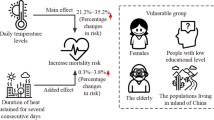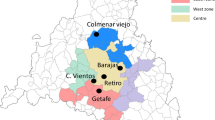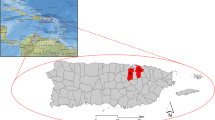Abstract
A substantial number of epidemiological studies have demonstrated an association between atmospheric conditions and human all-cause as well as cause-specific mortality. However, most research has been performed in industrialised countries, whereas little is known about the atmosphere–mortality relationship in developing countries. Especially with regard to modifications from non-atmospheric conditions and intra-population differences, there is a substantial research deficit. Within the scope of this study, we aimed to investigate the effects of heat in a multi-stratified manner, distinguishing by the cause of death, age, gender, location and socio-economic status. We examined 22,840 death counts using semi-parametric Poisson regression models, adjusting for a multitude of potential confounders. Although Bangladesh is dominated by an increase of mortality with decreasing (equivalent) temperatures over a wide range of values, the findings demonstrated the existence of partly strong heat effects at the upper end of the temperature distribution. Moreover, the study demonstrated that the strength of these heat effects varied considerably over the investigated subgroups. The adverse effects of heat were particularly pronounced for males and the elderly above 65 years. Moreover, we found increased adverse effects of heat for urban areas and for areas with a high socio-economic status. The increase in, and acceleration of, urbanisation in Bangladesh, as well as the rapid aging of the population and the increase in non-communicable diseases, suggest that the relevance of heat-related mortality might increase further. Considering rising global temperatures, the adverse effects of heat might be further aggravated.







Similar content being viewed by others
References
Baccini M, Biggeri A, Accetta G, Kosatsky T, Katsouyanni K, Analitis A, Anderson H, Bisanti L, D’Ippoliti D, Danova J, Forsberg B, Medina S, Paldy A, Rabczenko D, Schindler C, Michelozzi P (2008) Heat effects on mortality in 15 European cities. Epidemiology 19(5):711–719
Bangladesh Bureau of Statistics (2008) Report on the Sample Vital Registration System 2007. Dhaka
Basu R (2009) High ambient temperature and mortality: a review of epidemiologic studies from 2001 to 2008. Environ Health 8(1):40
Basu R, Samet JM (2002) Relation between elevated ambient temperature and mortality: a review of the epidemiologic evidence. Epidemiol Rev 24(2):190–202
Becker S, Weng S (1998) Seasonal patterns of deaths in Matlab, Bangladesh. Int J Epidemiol 27(5):814–823
Bell ML, O’Neill MS, Ranjit N, Borja-Aburto VH, Cifuentes LA, Gouveia NC (2008) Vulnerability to heat-related mortality in Latin America: a case-crossover study in São Paulo, Brazil, Santiago, Chile and Mexico City, Mexico. Int J Epidemiol 37(4):796–804
Bhaskaran K, Hajat S, Haines A, Herrett E, Wilkinson P, Smeeth L (2009) Effects of ambient temperature on the incidence of myocardial infarction. Heart 95(21):1760–1769
Burkart K, Breitner S, Schneider A, Khan M, Krämer A, Endlicher W (2011a) The effect of atmospheric thermal conditions and urban thermal pollution on all-cause and cardiovascular mortality in Bangladesh. Environ Pollut 159(8–9):2035–2043
Burkart K, Khan M, Krämer A, Breitner S, Schneider A, Endlicher W (2011b) Seasonal variations of all-cause and cause-specific mortality by age, gender, and socio-economic condition in urban and rural areas of Bangladesh. Int J Equity Health 10:32
Curriero FC, Heiner KS, Samet JM, Zeger SL, Strug L, Patz JA (2002) Temperature and mortality in 11 cities of the Eastern United States. Am J Epidemiol 155(1):80–87
Fouillet A, Rey G, Laurent F, Pavillon G, Bellec S, Guihenneuc-Jouyaux C, Clavel J, Jougla E, Hémon D (2006) Excess mortality related to the August 2003 heat wave in France. Int Arch Occup Environ Health 80(1):16–24
Gasparrini A, Armstrong B, Kenward MG (2010) Distributed lag non-linear models. Stat Med 29(21):2224–2234
Gosling SN, Warren R, Arnell NW, Good P, Caesar J, Bernie D, Lowe JA, van der Linden P, O’Hanley JR, Smith SM (2011) A review of recent developments in climate change science. Part II: the global-scale impacts of climate change. Prog Phys Geogr 35(4):443–464
Gosling S, McGregor G, Lowe J (2012) The benefits of quantifying climate model uncertainty in climate change impacts assessment: an example with heat-related mortality change estimates. Clim Chang 112:217–231
Gouveia N, Hajat S, Armstrong B (2003) Socioeconomic differentials in the temperature–mortality relationship in São Paulo, Brazil. Int J Epidemiol 32(3):390–397
Hashizume M, Armstrong B, Hajat S, Wagatsuma Y, Faruque ASG, Hayashi T, Sack DA (2007) Association between climate variability and hospital visits for non-cholera diarrhoea in Bangladesh: effects and vulnerable groups. Int J Epidemiol 36(5):1030–1037
Hashizume M, Wagatsuma Y, Hayashi T, Saha SK, Streatfield K, Yunus M (2009) The effect of temperature on mortality in rural Bangladesh—a population-based time-series study. Int J Epidemiol 38(6):1689–1697
Ishigami A, Hajat S, Kovats RS, Bisanti L, Rognoni M, Russo A, Paldy A (2008) An ecological time-series study of heat-related mortality in three European cities. Environ Health 7(1):5
Jaffar S, Leach A, Greenwood A, Jepson A, Muller O, Ota M, Bojang K, Obaro S, Greenwood B (1997) Changes in the pattern of infant and childhood mortality in Upper River Division, The Gambia, from 1989 to 1993. Tropical Med Int Health 2(1):28–37
Jendritzky G, Havenith G, Weihs P, Batchvarova E, DeDear R (2007) The Universal Thermal Climate Index UTCI. NCUB London, London
Kaiser R, Le Tertre A, Schwartz J, Gotway C, Daley W, Rubin C (2007) The effect of the 1995 heat wave in Chicago on all-cause and cause-specific mortality. Am J Public Health 97(1):158–162
Kelishadi R, Alikhani S, Delavari A, Alaedini F, Safaie A, Hojatzadeh E (2008) Obesity and associated lifestyle behaviours in Iran: findings from the First National Non-communicable Disease Risk Factor Surveillance Survey. Public Health Nutr 11(3):246–251
Khan MMH, Krämer A, Grübner O (2009) Comparison of health-related outcomes between urban slums, urban affluent and rural areas in and around Dhaka megacity, Bangladesh. Die Erde 140(1):69–87
Klinenberg E (2002) Heat wave: a social autopsy of disaster in Chicago. University Of Chicago Press, Chicago
Matzarakis A, Rutz F, Mayer H (2007) Modelling radiation fluxes in simple and complex environments—application of the RayMan model. Int J Biometeorol 51:323–334
McGregor IA, Billewicz WZ, Thomson AM (1961) Growth and mortality in children in an African village. Br Med J 2(5268):1661–1666
McGregor G, Pelling M, Wolf T, Gosling S (2007) The social impacts of heat waves. Science Report SC20061/SR6. Environment Agency, Bristol. ISBN 978-1-84432-811-6
McMichael AJ, Wilkinson P, Kovats RS, Pattenden S, Hajat S, Armstrong B, Vajanapoom N, Niciu EM, Mahomed H, Kingkeow C, Kosnik M, O’Neill MS, Romieu I, Ramirez-Aguilar M, Barreto ML, Gouveia N, Nikiforov B (2008) International study of temperature, heat and urban mortality: the "ISOTHURM" project. Int J Epidemiol 37(5):1121–1131
Medina-Ramón M, Schwartz J (2007) Temperature, temperature extremes, and mortality: a study of acclimatisation and effect modification in 50 US cities. Occup Environ Med 64:827–833
Murray CJL, Lopez AD (1997) Alternative projections of mortality and disability by cause 1990–2020: Global Burden of Disease Study. Lancet 349(9064):1498–1504
Nastos P, Matzarakis A (2012) The effect of air temperature and human thermal indices on mortality in Athens, Greece. Theor Appl Climatol 108(3–4):591–599
O’Neill M, Hajat S, Zanobetti A, Ramirez-Aguilar M, Schwartz J (2005) Impact of control for air pollution and respiratory epidemics on the estimated associations of temperature and daily mortality. Int J Biometeorol 50(2):121–129
O’Neill MS, Zanobetti A, Schwartz J (2003) Modifiers of the temperature and mortality association in seven US cities. Am J Epidemiol 157(12):1074–1082
O’Neill MS, Hajat S, Zanobetti A, Ramirez-Aguilar M, Schwartz J (2005) Impact of control for air pollution and respiratory epidemics on the estimated associations of temperature and daily mortality. Int J Biometeorol 50(2):121–129
Proctor MH, Moore LL, Singer MR, Hood MY, Nguyen US, Ellison RC (1996) Risk profiles for non-communicable diseases in rural and urban schoolchildren in the Republic of Cameroon. Ethn Dis 6(3–4):235–243
Rau R (2006) Seasonality in human mortality. A demographic approach. Springer, Berlin
Reddy KS, Yusuf S (1998) Emerging epidemic of cardiovascular disease in developing countries. Circulation 97(6):596–601
Robine J-M, Cheung SL, Le Roy S, Van Oyenm H, Herrmann FR (2007) Report on excess mortality in Europe during summer 2003. 2003 Heat Wave Project. EU Community Action Programme for Public Health, Grant Agreement 2005114
Schär C, Jendritzky G (2004) Climate change: Hot news from summer 2003. Nature 432(7017):559–560
Shetty PS (2002) Nutrition Transition in India. Public Health Nutr 5(1A):175–182
Smoyer K, Rainham D, Hewko J (2000) Heat-stress-related mortality in five cities in southern Ontario: 1980–1996. Int J Biometeorol 44(4):190–197
Stafoggia M, Forastiere F, Agostini D, Caranci N, de’Donato F, Demaria M, Michelozzi P, Miglio R, Rognoni M, Russo A, Perucci CA (2008) Factors affecting in-hospital heat-related mortality: a multi-city case-crossover analysis. J Epidemiol Community Health 62(3):209–215
United Nations (2004) World population to 2300. United Nations, New York
United Nations (2008) World Urbanization Prospects: The 2007 Revision. United Nations, New York
Wakefield J, Salway R (2001) A statistical framework for ecological and statistical studies. J R Stat Soc 164(1):119–137
Wood S (2006) Generalized additive models: an introduction with R. Chapman & Hall/CRC, London
World Health Organisation (2010) Noncommunicable disease risk factors and socioeconomic inequalities—what are the links? A multicountry analysis of noncommunicable disease surveillance data. Western Pacific Region. WHO, Geneva
Author information
Authors and Affiliations
Corresponding author
Rights and permissions
About this article
Cite this article
Burkart, K., Breitner, S., Schneider, A. et al. An analysis of heat effects in different subpopulations of Bangladesh. Int J Biometeorol 58, 227–237 (2014). https://doi.org/10.1007/s00484-013-0668-5
Received:
Revised:
Accepted:
Published:
Issue Date:
DOI: https://doi.org/10.1007/s00484-013-0668-5




